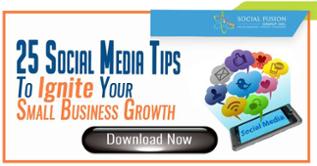Content marketing has become a big part of online business during the past decade, and there is no sign of it going away soon. Last year, we published about the shift in content marketing and also steps on how you can adapt to the evolution of content. But just like last year, content has continued to evolve.
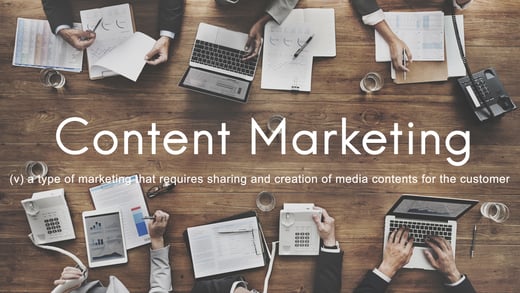
With more articles being published today than ever before, standing out in the crowd remains to be a struggle many businesses face. This means that as creators, you'll need to be adaptive and strategic in the way you approach marketing your content in 2019 (and onward.)
Content Marketing in 2019
In a recent Backlinko post, Brian Dean teamed up with Buzzsumo to analyze 912 million blog posts. They analyzed these posts in an attempt to understand how factors like
What they found was:
- On average, long-form content gets 77.2% more external links than shorter pieces of content.
- Longer content posts also performed well for acquiring social shares, however, the study did find diminishing returns when it came to articles which surpassed 2,000 words.
- The vast majority of online content gets little to no backlinks. Specifically, 94% of all blog posts have zero external links.
- A very small percentage of posts manages to get a disproportionate amount of social shares. More specifically, 1.3% of articles generate 75% of all social shares.
- They found that there is virtually no correlation between social shares and backlinks. Contrary to popular belief, this finding suggests that there’s very little correlation between highly-shareable content and content that people tend to link to.
- Long headlines are linked to higher social sharing. Specifically, headlines that were between 14-17 words generated 76.7% more social shares than those comprised of less than 14 words.
- Headlines that pose a question, on average, get 23.3% more social shares than those that don’t end with a question mark.
- There’s no best time to publish a new piece of content. Social shares are evenly distributed among posts published on different days of the week.
- Lists posts perform the best in terms of generating social shares. Specifically, list posts get 218% more shares than “how to” posts and 203% more shares than infographics (on average.)
- The study found that “Why Posts”, “What Posts” and infographics worked best for backlinking; receiving 25.8% more
links when compared to videos and “How-to” posts.
- The average blog post gets 9.7x more shares than B2B posts. However, the distribution of links and shares for both B2B and B2C publications appears to be similar.
What Kind of Content Drives the Most Backlinks?
The study found that long blog posts significantly outperformed shorter articles. More specifically, they found that posts that exceeded 3000 words, got an average of 77.2% more backlinks that those under 1000 words.

Source: Backlinko
While there is no conclusive data as to why this happens, there might be a logical explanation for this. Long posts are often seen as authority pieces. They are correlated with heavy research and analysis that digs into a certain topic of interest with great detail. So if you wanted to reference a strong piece to further support your own, what would you rather link to? A long detailed, well-researched post, or one that scratches the surface?
The Google algorithm tends to favor long-form posts, often ranking them on page 1. Of course, the more high ranking backlinks a post has, the greater Google perceives the value of the post (which also contributes to better rankings.)
What Kind of Content Drives the Most Social Shares?
Once again, longer posts are favored here. Having said that, there is a point where the study found diminishing returns. More specifically, the “sweet spot” for maximizing social shares lies between 1000-2000 words and starts to decline for posts that exceed 2000 words.
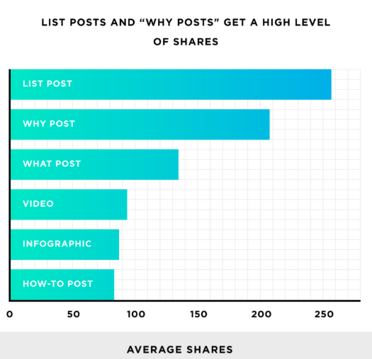
Source: Backlinko
Posts between 1000-2000 words showed an average of 56.1% more social shares than those less than 1000 words. Posts over 2000 words also showed less social "sharability," but the difference was not as notable as it was with smaller posts. But why? Previously we saw that Google and referrers prefer large >
One assumption might be that the majority of social network users are active on mobile devices. While it’s much easier today for someone to read an article on their phone or tablet (bigger screens, reading modes, more responsive sites, etc.) it is unlikely that a > 2000 word post would be read on such a device. Especially in today’s fast-paced world where most of us might glance at our phones for a few minutes and then move on.
Why Does the Majority of Content get 0 Backlinks?
Backlinks have always been one of the major signals used by Google to help rank a piece of content. According to Google, the more sites that link back to a specific page, the higher the indication that the page is perceived to be authoritative. Since people are linking to the article, Google sees this as quality content people want to consume.
While this sounds straight forward, actually getting these links is extremely difficult. In fact, the study showed that an astounding 94% of all content published gets 0 backlinks. To make matters worse, out of the pages that do get backlinks, only 2.2% receive links from multiple sites.
So why is this happening? Why is it so hard for a piece of content to get backlinks? While there is no definitive answer, Brian Dean suggests that it’s probably due to a massive influx of content published daily.
He supports this claim by illustrating data gathered from a Wordpress report. More specifically, it showed that content published on their platform alone had risen by 47.1% between May 2016 – May 2018. Similarly, a study published on Moz.com’s blog showed that during 2015, 75% of the content being examined had no external sites linking back to them. That’s a considerable difference between 94% today.
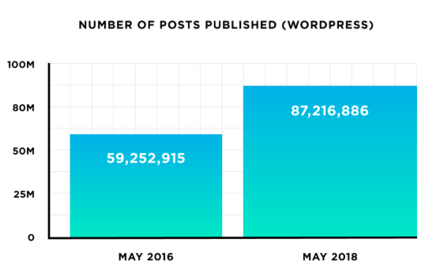
Source: Backlinko
This makes sense. The more content that is being published (many of which around a similar or even identical topic,) the harder it is for creators to find and link to one that stands out from the rest. This means that only the absolute best articles will be worthy of backlinks, potentially explaining why such massive posts are those being linked to (as we saw previously.)
How are Social Shares Distributed Among All Posts?
Contrary to popular belief, the derivation among articles that generate a considerable amount of social sharing is extremely small. In fact, only 1.3% of all articles posted get 75% of all social shares. Out of this extremely small percent, an even smaller subset of 0.1% of articles generated 50% of the total amount of social shares.
While there is no conclusive answer as to why this happens, there is a possibility that there are posts (such as those mentioned earlier) that have a significant potential to go viral. Such posts are often topical, talk about something trending, and are concise with appealing titles.
Is There Any Correlation Between Backlinks and Social Shares?
The study found a Pearson correlation coefficient of 0.078, meaning that there is virtually no correlation between backlinks and social shares. So content that generates multiple backlinks usually does not generate significant social shares (and vice versa.)
This is another surprising factor found in the study. Social sharing has long been considered a viable SEO tactic. The more exposure your piece of content gets on social media, the higher the likelihood of people linking back to it, therefore increasing your content's authority and potential for better ranking. While this is a valid theory, it’s not the case for the 900+ million posts examined.
The author refers to a study in which Steve Rayson is quoted saying “People share and link to content for different reasons.”
What this essentially means is that you will need to determine what your ultimate goals are (generating backlinks or social shares) and cater your content to fit that need.
Do Headlines Matter When Trying to Generate Backlinks and Social Shares?
While the length of the headline has little effect on generating backlinks, it was found to play a significant role when aiming to generate sharability on social platforms. More specifically, headlines in the range between 14-17 words and 80-100 characters significantly outperformed (76.7%) those that were shorter.
While longer headlines in the 900+ million posts examined showed that they generate more social shares, there are instances where short headlines (6 words) generated a significant amount of shares. This was mainly due to more “clickbait” type headlines, however, these types of posts have seen a significant drop in popularity and effectiveness.
Brian Dean had 2 theories as to why longer headlines work so well in generating social shares.
- Longer headlines often contain more information when compared to short headlines. This “extra” information could potentially urge people to read a piece of content or watch a video that they otherwise might have not (potentially due to curiosity,) increasing the odds that it goes viral.
- Longer headlines contain more terms that can potentially “match” keyword searches in Google and on social media sites where people commonly search (like Twitter.) Again, this results in increased exposure, which could potentially lead to more shares.
Headlines That End With a Question Generate More Social Shares
The study found that headlines that ended in a question mark generated an additional 23.3% than those that didn’t. The reason for this is possibly because they add an element of intrigue for the reader; increasing their curiosity, and in effect their chances of clicking on the post to find the answer to the question posed.
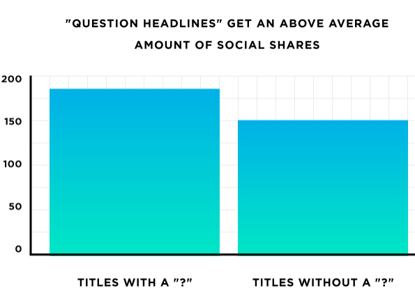
Source: Backlinko
When is it the Best Time to Publish New Content for Maximum Shares?
The study conducted found that there is no “best day” to publish new content for maximum social sharing. Average social shares for each day of the week was between 149-153. Note that these are averages are different for each industry.
What we (and the study) recommend is monitoring, testing, and refining your social publishing schedule to see which days your particular audience is most active. You might find that certain days, and even certain times are ideal for your business.
What Types of Posts Should You be Posting for Maximum Social Shares?
For social sharing, lists posts and “why” type posts worked best. This is possibly because these types of articles are easiest to skim through quickly. As we mentioned before, most social users consume content on their mobile devices, and therefore might be more attracted to content that they can go through fast and easy, while still gaining insight.
“How to” posts saw the least amount of social shares, potentially due to their higher complexity and greater analysis of a certain topic. What was surprising was the lack of social shares for video. The study did not specify the length nor the topics.
After some research, we found that the ideal length of video for social is 60 seconds, with Hubspot suggesting keeping them below 30 seconds. If you would like to see which video types and lengths work best for engagement on each social platform, be sure to check out the article by “2060digital” here.

What Types of Posts Should You be Posting for Maximum Backlinks?
The study found that infographics, “What Posts”, and “Why Posts” all received more backlinks than other content formats. Having said that, with a test pool of over 900 million articles, naturally, there was some overlap with the types of posts listed above, but the 3 post types mentioned earlier came on top in terms of referrals. This is potentially due to their more analytical nature when tackling a topic.
The following graphic does an excellent job of comparing the 2.
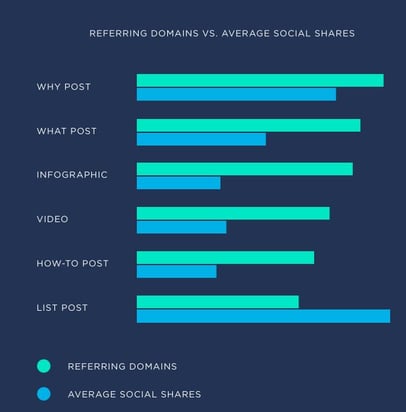
Source: Backlinko
There are instances that show some post performing exceptionally well in terms of social shares, but might have next to no backlinks. The author goes on to explain how he believes that there is no correlation between shares and backlinks. He continues to underline how he thinks that:
“...certain formats are primed to get shared on social networks like Facebook and Twitter. And other formats designed to get linked to from the small group of 'Linkerati' that run and contribute content to websites.”
A good example is that of “infographics.” While such content pieces might occasional go viral on social, it’s fair to say that their novelty has worn off in recent years. This might explain why they aren’t shared as much when compared to other formats. The fact that infographics contain highly-citable data allows them to work as effective forms of “link bait.” Moreover, unlike a list post or a “how to” post, infographics are easily embedded in blog content, further increasing their chances of getting linked to.
With that in mind, always take research with a grain of salt. Just because something works for the average user, it doesn’t mean that it will be the ideal situation for yourself. Always monitor and test the type of content you post, and try to find what you audience specifically likes to consume from you.
Which Performs Best, B2C or B2B Content?
In terms of shares, the study found that B2C outperforms B2B. This was no surprise. B2B content usually covers topics with a much broader appeal across a plethora of industries. B2B posts however, acted very similarly to how the +900 million sample did (which was comprised by both B2B and B2C posts.) More specifically:
- 93% of B2B content gets zero links from other websites, as did 94% of overall posts.
- Only 3% of B2B content got backlinks from more than 1 site, as did 2.2% of overall posts.
- 2% of B2B posts are accountable for 75% of social shares, similar to the 1.3% of overall posts.
- 5% of B2B posts are accountable for 50% of social shares, similar to the 0.1% of overall posts.
So the final takeaway here is that, while B2B content does not get shared as often as B2C (and for good reason,) the distribution between the two types of content is very similar.
And there you have it. One again we would like to thank Brian Dean from Backlinko for publishing this insightful analysis. For more of Brian be sure to check out his blog here. As always feel free to ask anything in the comments below, and feel free to follow us on Facebook and Twitter for more digital marketing insight.
For more reading on how you can make an impact with your online marketing, see the links below, and as always, feel free to join our Facebook Group.
- 10 Common Content Marketing Mistakes & How to Solve Them
- Content Marketing Is Shifting In 2018: Here's What You Need To Know
- Revitalize Your Marketing Strategy With This 5 Step Content Audit


